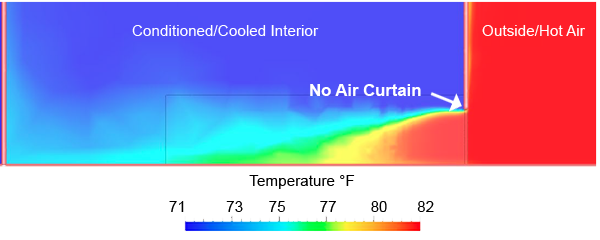The Impact of Air Curtains on Building Infiltration and Energy Efficiency
The American Society of Heating, Refrigerating and Air-Conditioning Engineers, collectively known as ASHRAE defines air infiltration as the uncontrolled inward leakage of outdoor air into buildings through cracks in the building envelope or through large openings such as doors. In simpler terms—it’s the outside air getting into your building. While the air itself may not be visible, it shows up in the form of uncomfortable indoor climates and increased energy bills.
Regardless of how efficient new buildings have become, outside air will enter through an open door whether the building was built in the last year or century. It’s calculated that infiltration accounts for an average of 25 percent of a building’s heating loads.
Air curtains are an ideal solution for reducing air infiltration and enhancing the energy efficiency of buildings with studies demonstrating that they significantly lower infiltration rates, improve building performance, and contribute to energy savings, especially in climates that are prone to varying weather conditions.
Lower Infiltration Rates
Air curtain doors have shown to reduce infiltration rates significantly compared to single doors. In tests conducted, the infiltration rates through doors utilizing air curtains were significantly lower than those on doors without. This reduced infiltration is crucial for maintaining indoor air quality, comfort, and energy efficiency.
Additionally, when compared to vestibule doors, air curtains also outperform in terms of infiltration control.
WITHOUT AN AIR CURTAIN

WITH AN AIR CURTAIN

The 2016 study by Sherif Goubran titled “The Energy Saving Impact of Air Curtains in Commercial Buildings” offers some of the most conclusive data as to the savings that can be achieved from Air Curtains. Two key excerpts show the following:
- For buildings in strip malls (retail areas) with a peak door usage of 34 Persons per Hour, the vestibule door’s air infiltration was 0.508 m3/s and air curtain door’s air infiltration was 0.196 m3/s. Thus the air curtain door reduced 61% of the infiltration as compared the vestibule door.
- For the outpatient healthcare building’s entrance with peak door usage of 123 Persons per Hour, the vestibule door’s air infiltration rate was 1.815 m3/s and the air curtain door’s air infiltration rate was 0.646 m3/s. Thus the air curtain door reduced 64% of the infiltration as compared to the vestibule door.
Greater Energy Efficiency and Cost Savings
One of the most compelling benefits of air curtain doors is their ability to reduce energy consumption. The reduction of infiltration in the entrance zone is directly tied to the operation hours of the air curtain. The longer the air curtain operates, the more it reduces air infiltration, leading to energy savings. Studies show that air curtain doors continue to save energy across various climate zones, even with variations in door usage frequency and wind pressure coefficients.

The study by Sherif Goubran also noted that factors such as building orientations, entrance door locations, and weather conditions can significantly affect air infiltration and exfiltration. These factors, combined with the hours of operation of the air curtain, ultimately impact the building’s energy performance. Notably, the air curtain’s ability to operate efficiently in a range of weather conditions, coupled with its low energy consumption, makes it a highly effective solution for reducing overall building energy use.
Conclusion
Considering the space-saving advantages, lower initial costs, and the potential for substantial energy savings, air curtains are an effective solution to combat infiltration and energy loss through both vestibule doors and single doors.
In climate zones 3 to 8, air curtain doors offer significant energy savings and perform well under a variety of conditions. They are also a valuable addition in climate zones 1 and 2, contributing to overall energy efficiency. As building designs continue to prioritize sustainability and energy conservation, air curtain doors represent a practical and cost effective solution for reducing air infiltration and improving building performance.
Here’s a summary of the key points from the information:
- Infiltration Rates: Air curtain doors show significantly lower infiltration rates compared to single doors and vestibule doors.
- Air Curtain Performance
- Supply Speed: The higher the air curtain’s supply speed, the better its performance, as it can handle higher pressure differences. However, higher speed may cause larger exfiltration.
- Supply Angle: A larger outward angle for the air curtain improves its ability to reduce air infiltration, but this could also lead to greater exfiltration under certain conditions.
- Wind Resistance: The air curtain door’s performance is barely affected by outdoor winds of up to 10 m/s.
- Person Blocking Infiltration: The presence of a person in the doorway can slightly improve the air curtain’s performance by blocking air infiltrations.
- Annual Infiltration Reduction: The air curtain door reduced infiltration by 4.60% in the strip mall building (nationwide average) and 40.70% in the outpatient healthcare building (local entrance zone).
